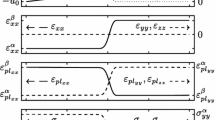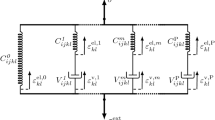Summary
A multiphase material is considered, which consists of a homogeneous elastoplastic matrix containing a homogenous statistically uniform random set of ellipsoidal elastic inclusions. An approach based on the multiparticle effective field method is introduced for determining the overall elastoplastic behavior of the material under monotonic loading. A secant modulus concept is employed, and linearized problems are solved at each step of an iterative procedure. Physically consistent assumptions are used for linearizing nonlinear functions which depend on the phase averages of the second invariant of stress and on the stress deviator. Exact expressions for the second moments of the microstresses are employed.
Similar content being viewed by others
References
Willis, J. R.: The overall elastic response of composite materials. J. Appl. Mech.50, 1202–1209 (1983).
Nemat-Nasser, S., Hori, M.: Micromechanics: overall properties of heterogeneous materials. Amsterdam: North-Holland 1993.
Kreher, W., Pompe, W.: Internal stress in heterogeneous solids. Berlin: Akademie-Verlag 1989.
Buryachenko, V. A., Parton, V. Z.: Effective field method in statics of composites. Prikl. Mekh. i Tekh. Fiz.5, 129–140 (1992) (in Russian; Engl. Transl.: J. Appl. Mech. & Techn. Phys.33, 735–745 (1992)).
Kunin, I. A.: Elastic media with microstructure. Berlin, Heidelberg, New York: Springer 1983.
Hill, R.: A self-consistent mechanics of composite materials. J. Mech. Phys. Solids13, 212–222 (1965).
Mori, T., Tanaka, K.: Average stress in matrix and average elastic energy of materials with misfitting inclusions. Acta Metall.21, 571–574 (1973).
Benveniste, Y.: A new approach to the application of Mori-Tanaka's theory in composite materials. Mech. Mater.6, 147–157 (1987).
Weng, G. J.: The theoretical connection between Mori-Tanaka's theory and the Hashin-Shtrikman-Walpole bounds. Int. J. Eng. Sci.28, 1111–1120 (1990).
Norris, A. N.: An examination of the Mori-Tanaka effective medium approximation for multiphase composites. ASME J. Appl. Mech.56, 83–88 (1989).
Benveniste, Y., Dvorak, G. J., Chen, T.: On the diagonal and elastic symmetry of the approxiamte effective stiffness tensor of heterogeneous media. J. Mech. Phys. Solids39, 927–946 (1991).
Qui, Y. P., Weng, G. J.: On the application of Mori-Tanaka's theory involving transversely isotropic spheroidal inclusions. Int. J. Eng. Sci.28, 1121–1137 (1990).
Buryachenko, V. A., Lipanov, A. M.: Stress concentration at ellipsoidal inclusions and effective thermoelastic properties of composite materials. Prikl. Mekh.11, 105–111 (1986) (in Russian; Engl. Transl.: Soviet Appl. Mech.22, 1103–1109 (1986)).
Buryachenko, V. A.: Correlation function of stress field in matrix composites. Mekhanika Tverdogo Tela3, 69–76 (1987) (in Russian; Engl. Transl.: Mech. Solids22, 66–73 (1987)).
Buryachenko, V. A., Parton, V. Z.: The efficient parameters of statistically nonhomogeneous matrix composites. Mekhanika Tverdogo Tela6, 55–63 (1990) (in Russian; Engl. Transl.: Mech. Solids25, 22–28 (1990)).
Buryachenko, V. A., Murov, V. A.: Effective conductivity of matrix composites. Inzhenerno Fiz. Zhurnal61, 2, 305–312 (1991) (in Russian; Engl. Transl.: J. Eng. Phys.61, 305–312 (1991)).
Buryachenko, V. A.: Effective viscoplasticity parameters of suspensions. Inzhenerno Fiz. Zhurnal58, 3, 452–456 (1990) (in Russian; Engl. Transl.: J. Eng. Phys.58, 331–334 (1990)).
Accorsi, M. L., Nemat-Nasser, S.: Bounds on the overall elastic and instantaneous elastoplastic moduli of periodic composites. Mech. Mater.5, 209–220 (1986).
Dvorak, G. J.: ASME 1992 Nadai lecture-Micromechanics of elastic composite materials: theory and experiment. ASME J. Eng. Mater. Technol.115, 327–338 (1993).
Böhm, H. J., Rammertstorfer, F. G., Weissenbek, E.: Some simple models for micromechanical investigations of fiber arrangement effects in MMCs. Comput. Mater. Sci.1, 177–194 (1993).
Weissenbek, E., Böhm, H. J., Rammerstorfer, F. G.: Micromechanical investigations of arrangement effects in particle reinforced metal matrix composites. Comput. Mater. Sci.3, 263–278 (1994).
Needleman, A., Tvergaard, V.: Comparison of crystal plasticity and isotropic hardening predictions for metal-matrix composites. ASME J. Appl. Mech.60, 70–76 (1993).
Nakamura, T., Suresh, S.: Effect of thermal residual stresses and fiber packing on deformation of metal-matrix composites. Acta Metall. Mater.41, 1665–1681 (1993).
Duva, J. M.: A constitutive description of nonlinear materials containing voids. Mech. Materials5, 137–144 (1986).
Lee, B. J., Mear, M. E.: Effect of inclusion shape on the stiffness of non-linear two-phase composites. J. Mech. Phys. Solids39, 627–649 (1991).
Hutchinson, J. W.: Elastic-plastic behavior of polycrystalline metals and composites. Proc. R. Soc. London Ser.A319, 247–272 (1970).
Nemat-Nasser, S., Obata, M.: Rate-dependent, finite deformation of polycristals. Proc. R. Soc. London Ser.A407, 377–404 (1986).
Hashin, Z.: Analysis of composite materials. ASME J. Appl. Mech.50, 481–505 (1962).
Zhu, Z. G., Weng, G. J.: A local theory for the calculation of overall creep strain of particle-reinforced composites. Int. J. Plasticity6, 449–469 (1990).
Bornert, M., Herve, E., Stolz, C., Zaoui, A.: Self-consistent approaches and strain heterogeneities in two-elastoplastic materials. Appl. Mech. Rev.47, Part 2, S66-S76 (1994).
Hashin, Z., Shtrikman, S.: A variational approach to the theory of the behavior of multiphase materials. J. Mech. Phys. Solids11, 127–140 (1963).
Talbot, D. R. S., Willis, J. R.: Variational principles for nonlinear inhomogeneous media. IMA J. Appl. Math.35, 39–54 (1985).
Willis, J. R., Taldom, G. J.: Variational methods in the theory of random composite materials. In: Continuum models and discrete systems (Maugin, G. A., ed.),1, pp. 113–131. London: Longman Scientific & Technical 1992.
Michel, J. C., Suquet, P.: The constitutive law of nonlinear viscous and porous materials. J. Mech. Phys. Solids40, 783–812 (1992).
Ponte Castañeda, P.: The effective mechanical properties of nonlinear isotropic composites. J. Mech. Phys. Solids39, 45–71 (1991).
Ponte Castañeda, P.: New variational principles in plasticity and their application to composite materials. J. Mech. Phys. Solids40, 1757–1788 (1992).
Berveiller, M., Zaoui, A.: An extension of the self-consistent scheme to plastically flowing polycristals. J. Mech. Phys. Solids26, 325–344 (1979).
Tandon, G. P., Weng, G. J.: A theory of particle-reinforced plasticity. ASME J. Appl. Mech.55, 126–135 (1988).
Buryachenko, V. A., Lipanov, A. M.: Effective characteristics of elastic physically nonlinear composites. Prikl. Mekh.26, 12–16 (1990) (in Russian; Engl. Transl.: Soviet Appl. Mech.26, 9–13 (1990)).
Arsenault, R. J., Taya, M.: Thermal residual stress in metal matrix composites. Acta Metall.35, 651–659 (1987).
Reifsnider, K. L., Gao, Z.: A micromechanics model for composites under fatigue loading. Int. J. Fatigue13, 149–156 (1991).
Lin, S. C., Yang, C., Mura, T., Iwakuma, T.: Average elastic-plastic behavior of composite materials. Int. J. Solids Struct. George Herrmann 70th Anniversary Issue28, 1859–1872 (1992).
Qui, Y. P., Weng, G. J.: The influence of inclusion shape on the overall elastoplastic behavior of a two-phase isotropic composite. Int. J. Solids Struct.27, 1537–1550 (1991).
Zhu, Z. G., Weng, G. J.: Creep deformation of particle-strengthened metal-matrix composites. ASME J. Eng. Mater. Technol.111, 99–105 (1989).
Ziegler, F.: Developments in structural dynamic viscoplaticity including ductile damage. ZAMM72, T5-T15 (1992).
Parton, V. Z., Buryachenko, V. A.: A stress fluctuation in elastic composites. Dok. AN SSSR310, 1075–1078 (1990) (in Russian; Engl. Transl.: Sov. Phys. Dokl.35, 191–193 (1990)).
Buryachenko, V. A.: Mechanics of random structure composites. In: Proc. of the Int. Conf. on Composites (Miravete, A., ed.), Vol.3, pp. 398–405. Zaragoza: Univ. Zaragoza 1993.
Buryachenko, V. A.: Effective strength properties of elastic physically nonlinear composites. In: Proc. of the MECAMAT Conf. Micromechanics of Materials (Marigo, J. J., Rousselier, G., eds.), pp. 567–578. Paris: Editions Eryolles 1993.
Buryachenko, V. A., Lipanov, A. M.: Equations of mechanics for gas-saturated porous matrix. Prikl. Mekh. Tekh. Fiz.4, 106–109 (1986) (in Russian; Engl. Transl.: J. Appl. Mech. Techn. Phys.27, 557–581 (1986)).
Buryachenko, V. A., Kreher, W. S.: Internal residual stresses in heterogeneous solids — A statistical theory for particulate composites. J. Mech. Phys. Solids43, 1105–1125 (1995).
Buryachenko, V. A., Parton, V. Z.: One-particle approximation of the effective field method in statics of composites. Mekh. Kompoz. Mater.3, 420–425 (1990) (in Russian; Engl. Transl.: Mech. Compos. Mater.26, 304–309 (1990)).
Ju, J. W., Chen, T. M.: Micromechanics and effective moduli of elastic composites containing randomly dispersed ellipsoidal inhomogeneities. Acta Mech.103, 103–121 (1994).
Kreger, I. W.: Rheology of monodisperse lattices. Adv. Colloid Interface Sci.3, 111–136 (1972).
Buryachenko, V. A., Lipanov, A. M.: Effective field method in the theory of perfect plasticity of composite materials. Prikl. Mekh. Tekh. Fiz.3, 149–155 (1989) (in Russian; Engl. Transl.: J. Appl. Mech. Techn. Phys.30, 482–487 (1989)).
Ju, J. W., Chen, T. A.: Micromechanics and effective elastoplastic behavior of twophase metal matrix composites. ASME J. Eng. Mater. Technol.116, 310–318 (1994).
Gurson, A. L.: Continuum theory of ductile rupture by void nucleation and growth: Part I-Yield criteria and flow rules for porous ductile media. ASME J. Eng. Mater. Technol.99, 2–15 (1977).
Koplik, J., Needleman, A.: Void growth and coalescence in porous plastic solids. Int. J. Solids Struct.24, 835–853 (1988).
Fotiu, P., Irschik, H., Ziegler, F.: Micromechanical foundations of dynamic plasticity with applications to damaging structures. In: Advances in continuum mechanics (Brüller, O., Mannl, V., Najar, J., eds.), pp. 338–349. Berlin: Springer 1991.
Buryachenko, V. A., Scorbov, Yu. S., Gunin, S. V.: Effective parameters of the strength composites. Probl. Prochnosti12, 47–51 (1991) (in Russian; Engl. Transl.: Strength Mater.23 (1991)).
Buryachenko, V. A.: Prediction of macroproperties of composite medium by the elastoplastic method of effective fields. Probl. Prochnosti11, 72–76 (1990) (in Russian; Engl. Transl.: Strength Mater.22, 1645–1650 (1990)).
Buryachenko, V. A., Lipanov, A. M., Kozhevnikova, Yu. G.: Effective properties of elastoplastic porous materials. Probl. Prochnosti1, 36–39 (1991) (in Russian; Engl. Transl.: Strength Mater.23, 41–45 (1991)).
Qui, Y. P., Weng, G. J.: A theory of plasticity for porous materials and particle-reinforced composites. ASME J. Appl. Mech.59, 261–268 (1992).
Bhattacharyya, A., Weng, G. J.: The elastoplastic behavior of a class of two-phase composites containing rigid inclusions. Appl. Mech. Rev.47, 45–65 (1994).
Buryachenko, V. A., Lipanov, A. M.: Predicting the parameters of a nonlinear flow of multicomponent mixtures. Prikl. Mekh. Tekh. Fiz.4, 63–68 (1989) (in Russian; Engl. Transl.: J. Appl. Mech. Techn. Phys.30, 558–562, (1989)).
Ponte Castañeda, P.: Effective properties in power-law creep. In: Micromechanics of creep of brittle materials (Cocks, A. L. F., Ponter, A. R. S., eds.)2, pp. 218–229. London: Elsevier 1991.
Kremesec, V. J., Slattery, J. C.: The apparent stress-deformation of spheres in power-model fluid. J. Rheol.21, 459–461 (1977).
Bao, G., Hutchinson, J. W., McMeeking, R. M.: Particle reinforcement of ductile matrices against plastic flow and creep. Acta Metall.39, 1871–1880 (1991).
Han, C. D.: Rheological properties of calcium carbonate filled polypropylene melts. J. Appl. Pol. Sci.18, 821–829 (1974).
Buryachenko, V., Böhm, H., Rammerstorfer, F.: Modeling of the overall elastoplastic behavior of multiphase materials by the effective field method. In: IUTAM Symp. on Plasticity and Damage of Multiphase Materials (Pineau, A., Zaoui, A., Pyrz, R., eds.). Dordrecht: Kluwer 1996 (in press).
Buryachenko, V. A., Rammerstorfer, F. G.: Micromechanics of elastoplastic deformation of two-phase metal matrix composites. In: Second Int. Conf. on Composites Engineering (Hui, D., ed.), pp. 617–618. New Orleans: Univ. of New Orleans 1995.
Buryachenko, V. A., Rammerstorfer, F. G.: Elastoplastic behavior of elastically homogeneous materials with a random field of inclusions. In: 8th Int. Symp. on Continuum Models and Discrete Systems, Varna (Markov, K. Z., ed.), pp. 140–147. Singapore: World Scientific 1996.
Author information
Authors and Affiliations
Rights and permissions
About this article
Cite this article
Buryachenko, V.A. The overall elastopIastic behavior of multiphase materials with isotropic components. Acta Mechanica 119, 93–117 (1996). https://doi.org/10.1007/BF01274241
Received:
Revised:
Issue Date:
DOI: https://doi.org/10.1007/BF01274241




